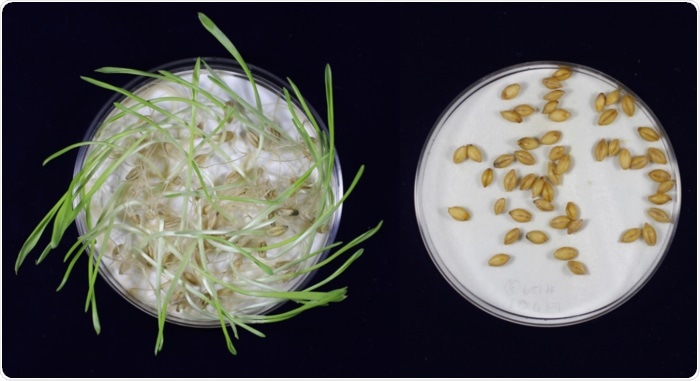Unexpected rain before the harvest season leaves the farmer with a problem—untimely sprouting of barley. Sprouted barley fetches less price on the market, thus posing an economic burden on farmers and corporations—both at the mercy of nature to survive in the agriculture industry. The worsening climate change too added to this situation.

Germination in the non-mutated barley was almost complete, while the gene-edited barley did not germinate at all. This shows that the gene-edited barley had been dormant for longer (images taken 7 days after imbibition). Image Credit: Hiroshi Hisano from Okayama University.
Agricultural scientists were looking into the problem of pre-harvest sprouting for a long time now. Pre-harvest sprouting can be prevented by genetically manipulating grains to prolong dormancy. But this kind of dormancy interferes with malt production and also results in non-uniform germination when sowing. Hence a high-quality barley production needs to balance these problems.
Recently, a group of researchers headed by Associate Professor Dr Hiroshi Hisano from Okayama University, Japan, provide a solution to this age-old problem. To attain the “perfect” barley, the researchers analyzed the state-of-the-art gene manipulation technology—CRISPR/Cas9-based gene editing.
Dr Hisano describes the motivation to lead the art of perfecting barley.
We recognized the need to strategically manipulate crops to weather the effects of steadily exacerbating climate change. Since our collaborative research group had already developed expertise in precision genome editing of barley, we decided to go with the same initially. Also, previous studies have pinpointed specific grain and seed dormancy genes in barley, called Qsd1, and Qsd2. Hence, our modus operandi was pretty clear.”
Dr Hiroshi Hisano, Associate Professor, Okayama University
The observations were published in the journal Plant Biotechnology.
To attain the barley of interest, Dr Hisano and his group genetically manipulated samples of “Golden Promise” barley through CRISPR/Cas9 targeted mutagenesis. They manipulated the barley to be either single mutants (qsd1 or qsd2) or double mutants (qsd1 and qsd2) and proceeded to carry out germination assays on all mutants and non-mutated samples.
Eventually, the results obtained for the mutants compared to non-mutants were highly interesting. All the mutants exhibited delayed germination; however, there were mutant-specific or conditional properties. Germination of mutants was induced by 3% hydrogen peroxide treatment and was exposed to cold temperatures to trigger germination.
This showed that the grains of the mutants were not dead but were being dormant longer. The qsd1 mutation in single mutants moderately decreased long-grain dormancy due to qsd2, and qsd2 mutants were capable of germinating in the dark and not in the light. All mutants revealed abscisic acid build-up, consistent with conditions seen in delayed germination.
Remarkably, this abscisic acid build-up by itself cannot retain long-term grain dormancy, the latter being vital for high-quality barley production. The scientists are overjoyed with the results of the plant biotechnology endeavor.
We could successfully produce mutant barley that was resistant to pre-harvest sprouting, using the CRISPR/Cas9 technology. Also, our study has not only clarified the roles of qsd1 and qsd2 in grain germination or dormancy but has also established that qsd2 plays a more significant role.”
Dr Hiroshi Hisano, Associate Professor, Okayama University
The current research serves as a milestone for the current and future crop improvement research by employing effective gene manipulation like the ones provided by CRISPR/Cas9. The scientists are optimistic that the food and environmental problems that humans are facing globally can be solved by employing their improved biotechnology techniques.
The world too anticipates with them for a better beer!
Source:
Journal reference:
Hisano, H., et al. (2021) Regulation of germination by targeted mutagenesis of grain dormancy genes in barley. Plant Biotechnology Journal. doi.org/10.1111/pbi.13692.